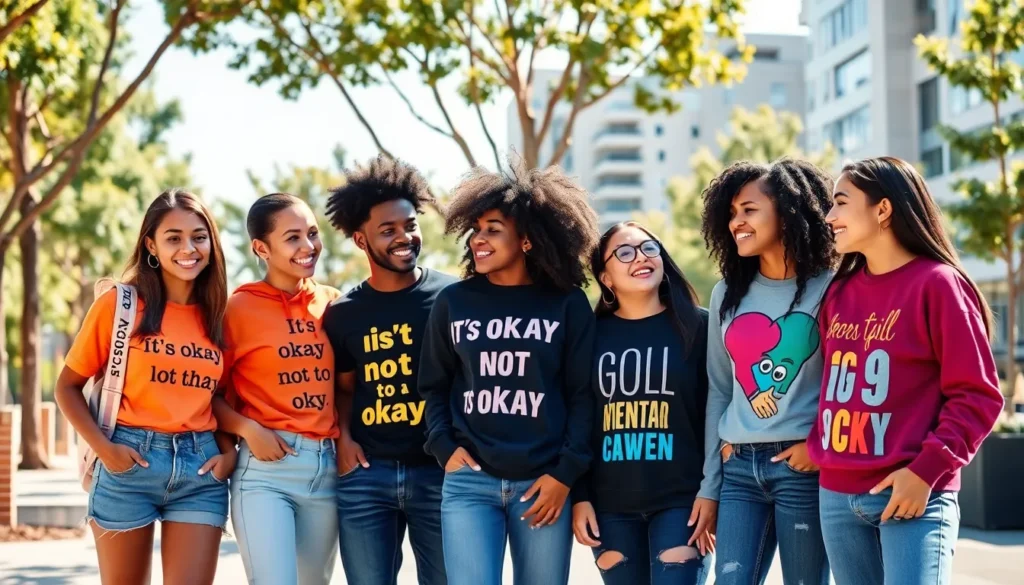Table of Contents
ToggleHave you ever thought about how your clothes could be an ally in the quest for mental health awareness? Picture this: you stroll down the street in a shirt that not only sparks conversations but also promotes understanding and empathy. Pretty neat, right? Mental health matters clothing isn’t just a trend, it’s a movement that combines style with substance. So, let’s jump into why this intersection of fashion and mental health is crucial, and how you can be a part of it without sacrificing your wardrobe or your sense of humor.
The Importance of Mental Health Awareness

In recent years, mental health awareness has gained visibility, yet stigmas and misconceptions continue to linger. According to the World Health Organization, approximately one in four individuals will experience a mental health disorder at some point in their lives. That’s a staggering number. But awareness is the first step toward acceptance and treatment. By discussing mental health openly, society can dismantle barriers and encourage more people to seek help. This is where clothing steps in, it’s a conversation starter, a statement, and a way to show solidarity with those navigating mental health challenges.
Why Clothing Can Be a Powerful Tool
Fashion communicates without words. A simple t-shirt can convey messages that resonate deeply, and that’s powerful. Clothing can evoke feelings of belonging and safety, promote self-expression, and even challenge societal norms. When someone wears a shirt that says, “It’s okay not to be okay,” it invites discussion. Recognizing this potential, mental health advocates have harnessed the power of apparel to foster environments of support and openness. It’s not just about looking good: it’s about feeling good and promoting important conversations around mental well-being.
Exploring Mental Health Fashion Trends
The landscape of mental health fashion continues to evolve, embracing creativity and consciousness. Recent trends have introduced vibrant graphics and uplifting messages across various clothing lines. From cozy sweatshirts with heartwarming quotes to bold statement pieces adorned with artwork reflecting mental health themes, these garments serve as more than just fabric. They are dialogue pieces, bridging gaps in understanding and encouraging conversations. Plus, who doesn’t love cozying up in a comfy hoodie that also sends a positive message? Everyone deserves to express themselves, and fashion can help that.
Brands That Support Mental Health Initiatives
Several brands have taken up the mantle of supporting mental health initiatives through their apparel. For example, Mental Health America and The Trevor Project collaborate with various clothing companies to create stylish pieces that promote awareness and support. Contemplating the power of your purchases can lead to impactful contributions. Every purchase can ripple out, funding vital resources and awareness campaigns. Brands that give back not only look good on your body: they feel good for your conscience too.
How to Choose Clothing That Promotes Mental Well-Being
Choosing clothing that promotes mental well-being involves more than selecting a cool design. It’s about finding pieces that resonate personally. Look for brands with authentic messages and a commitment to mental health issues, ensuring your clothes reflect your values. Participate in styles that foster comfort, think fabrics that feel good against your skin and cuts that allow for movement. Choose colors that lift your spirits: vibrant shades can boost mood, while soft tones provide a calming presence. The key here is to align your wardrobe with a mindset that promotes positivity and self-care.
Personal Stories and Impact
One powerful aspect of mental health matters clothing is its ability to foster community through personal stories. Many individuals share their journeys through mental health struggles on social media while wearing supportive outfits. It’s a sight to behold: someone wearing a crafted piece that shares their mantra, demonstrating vulnerability and resilience. These stories connect people: they highlight experiences and show that no one is alone in their struggles. This communal spirit transforms the fabric of these garments into vessels of healing and solidarity.







